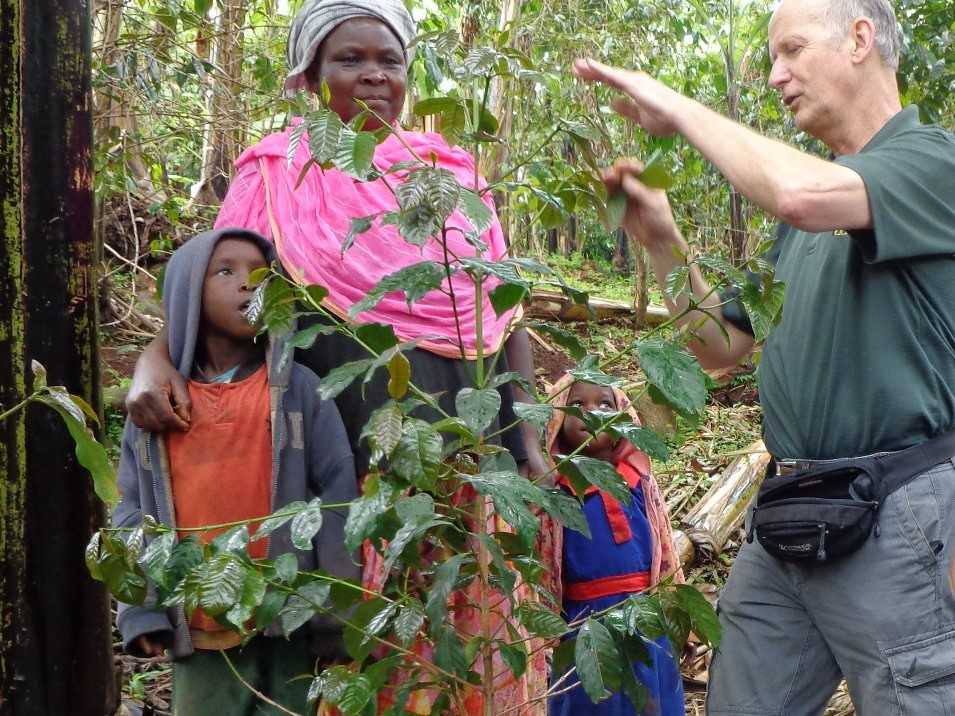A North Dakota State University crop production expert has been helping Ugandan farmers find ways to increase their country’s coffee production. “Coffee is a major agricultural commodity in Africa,” says Hans Kandel, NDSU Extension Service agronomist and a professor in the university’s Plant Sciences Department.
“African countries export about 21 percent of internationally traded coffee. Of those countries, Uganda is the leading exporter from Africa. Coffee produces income for smallholders, and coffee production also constitutes 20 percent of the Ugandan national export revenues.”
Smallholders operate small farms that generally support a single extended family. A smallholder farm mostly will use the family for labor and grow various crops for food and sale to generate cash income.
Kandel was in Uganda from the end of April to the middle of May to evaluate the coffee production system from input (chemicals, seed, etc.) suppliers to exporters. The goal of his trip was to identify areas for improvement and help develop a project that can increase Uganda’s coffee production, improve the producers’ knowledge of coffee production and their growing practices, and increase income for subsistence coffee producers.
He visited agricultural input suppliers, smallholder farmers, cooperatives, and coffee purchasers, processors and exporters. The Farmer-to-Farmer program funded by the U.S. Agency for International Development (USAID) supported the trip. In Uganda, Kandel was hosted by Catholic Relief Services.
The main type of coffee produced in Uganda is Robusta, which grows well at an altitude of 2,900 to 5,000 feet. It’s mainly found in a 190-mile radius around Lake Victoria. Uganda’s Robusta coffee is considered to be one of the best in the world and commands a considerable premium. The majority of Ugandan coffee is exported to European Union countries.
Uganda has approximately 500,000 smallholder coffee farms. Each has less than 2.4 acres of land. Many farmers depend on the coffee crop as their main source of income.
On many Ugandan farms, coffee is intercropped with plantain (bananas), which is a main staple food. A variety of other crops, including several bean types, also might be planted in the coffee garden or separate fields.
Uganda’s coffee yield per acre has been declining since the 1990s. The two main reasons for this reduction are the age of the coffee trees (older trees are less productive) and coffee wilt disease, which can kill the tree.
“Various Ugandan and international organizations, including USAID, and agencies have identified coffee as a commodity to concentrate on with development interventions,” Kandel says.
The most common focus areas for improvements are in crop productivity through higher levels of coffee management practices. Some of the practices Kandel recommended are using adapted disease- and pest-resistant Robusta coffee clones, pruning and de-suckering coffee plants, controlling soil erosion and controlling various pest/diseases with pesticides.
Improving soil nutrient management and fertility is another way the Ugandan coffee growers can increase their plants’ productivity. Kandel says soil nutrients can be improved by a variety of methods, including using household compost, ashes from cooking fires, farmyard manure, mulch and/or artificial fertilizers. The productivity per unit of land also can be increased by intercropping with legume-type crops and using shade and/or banana trees.
Kandel observed dry beans intercropped in the coffee that were dark green and had great nodulation.
“There also were beans that were yellow and did not have nitrogen-fixing nodules on the roots,” he says. “The best remedy is to inoculate the beans with the right type of bacteria.”
He taught Ugandans the basics of inoculation and nitrogen fixation, and was able to connect with a project to supply farmers with bean inoculant.
“Another way to increase the farm income is by adding value to the coffee production at the farm level,” Kandel says. “This is done by increased attention to quality by picking only ripe berries, properly drying the crop at the farm and de-husking the coffee at the farm instead of selling the coffee berries fresh.”
Many of these improvements can be made with small management changes, according to Kandel.
“Changes in management often require a re-allocation of the family resources – land, labor, management time and cash – but if practiced intentionally, these changes could lead to a higher family income,” he says.


















